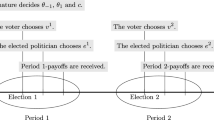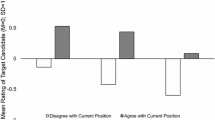Abstract
I studied the effects of monitoring on political turnover, when the politicians’ early actions affect future economic outcomes. I considered an infinite-horizon environment, where the expectation about the potential successor’s policy is endogenous. As a result, the incentive to replace the incumbent is endogenous. In a stationary Markov equilibrium, the relationship between monitoring and turnover is non-monotone. The model sheds light on dynamic agency problems when the agent’s initial effort has persistent effects, and on the role of reputation in models with endogenous turnover.


Similar content being viewed by others
Notes
A version of the model with \(\infty \)-lived politicians can be found at https://sites.google.com/site/jacekrothert/research.
The symmetry of means is imposed for ease of the exposition. It does not matter for the results.
Krusell and Rios-Rull (1996) develop a political economy theory where the political influence of the incumbent innovators allows them to prohibit the adoption of newer and better technologies. Then, \(B\) can be interpreted as a cost a politician in power would have to pay to oppose such lobbying.
See Appendix “Distribution of \(\log R(q)\)” for derivation.
See Appendix “Conditional probabilities of being removed” for derivations.
An alternative would be to introduce an independent signal (in addition to \(q\)) about the type of policy in place. The conclusions would be the same. In fact, they would hold for an arbitrary utility function.
The formal analysis can be found in a working paper version of the paper at https://sites.google.com/site/jacekrothert/research.
References
Alesina, A., Ozler, S., Roubini, N., Swagel, P.: Political instability and economic growth. J. Econ. Growth 1(2), 189–211 (1996)
Atkeson, A., Hellwig, C., Ordonez, G.: Optimal regulation in the presence of reputation concerns. National Bureau of Economic Research, Working Paper Series. Article No 17898 (2012)
Banks, J.S., Sundaram, R.K.: Optimal retention in agency problems. J. Econ. Theory 82(2), 293–323 (1998)
Besley, T.: Political selection. J. Econ. Perspect. 19(3), 43–60 (2005)
Brown, G. W.: Iterative solution of games by fictitious play. Wiley, New York, pp. 374–376 (1951)
Campos, N.F., Karanasos, M.G.: Growth, volatility and political instability: non-linear time-series evidence for Argentina, 1896–2000. Econ. Lett. 100(1), 135–137 (2008)
Caselli, F., Morelli, M.: Bad politicians. J. Pub. Econ. 88(3–4), 759–782 (2004)
Fudenberg, D., Levine, D.K.: The theory of learning in games. MIT press (1998)
Heinkel, R., Stoughton, N.M.: The dynamics of portfolio management contracts. Rev. Financ. Stud. 7(2), 351–387 (1994)
Holmstrom, B.: Moral hazard and observability. Bell J. Econ. 10(1), 74–91 (1979)
Hopenhayn, H., Jarque, A.: Unobservable persistent productivity and long term contracts. Rev. Econ. Dyn. 13(2), 333–349 (2010)
Jarque, A.: Repeated moral hazard with effort persistence. J. Econ. Theory 145(6), 2412–2423 (2010)
Krusell, P., Rios-Rull, J.-V.: Vested interests in a positive theory of stagnation and growth. Rev. Econ. Stud. 63(2), 301–329 (1996)
Martinez, L.: A theory of political cycles. J. Econ. Theory 144(3), 1166–1186 (2009)
Mukoyama, T., Sahin, A.: Repeated moral hazard with persistence. Econ. Theory 25(4), 831–854 (2005)
Ordonez, G.: Reputation from nested activities. Econ. Theory 52(3), 915–940 (2013)
Phelan, C.: Public trust and government betrayal. J. Econ. Theory 130, 27–43 (2006)
Riboni, A.: Ideology and endogenous constitutions. Econ. Theory 52(3), 885–913 (2013)
Spear, S.E., Wang, C.: When to fire a ceo: optimal termination in dynamic contracts. J. Econ. Theory 120(2), 239–256 (2005)
Acknowledgments
I thank the Associate Editor and an anonymous referee for the comments and suggestions that vastly improved the paper. I also want to thank Tim Kehoe and Fabrizio Perri for their patient advice at the early stages of this project.
Author information
Authors and Affiliations
Corresponding author
Additional information
Financial support from the University of Minnesota Graduate Research Partnership Program Fellowship is gratefully acknowledged.
Appendix: Derivations
Appendix: Derivations
1.1 Distribution of \(\log R(q)\)
The log likelihood of \(q\) is \(\log R(q)\) given by:
where \(\phi \) is the standard normal pdf. Thus, we get
Hence,
Since
we get:
1.2 Conditional probabilities of being removed
Since under a good policy we have \(\log R(q) \sim N\left( 2 \frac{\mu ^2}{\sigma ^2}, 4 \frac{\mu ^2}{\sigma ^2}\right) \), we get the following:
But \(\frac{\log R(q) - 2 \mu ^2/\sigma ^2 }{2 \mu /\sigma } \sim N(0,1)\), so
where \(\varPhi \) is the standard normal CDF. In a similar way we obtain that
Rights and permissions
About this article
Cite this article
Rothert, J. Monitoring, moral hazard, and turnover. Econ Theory 58, 355–374 (2015). https://doi.org/10.1007/s00199-014-0823-1
Received:
Accepted:
Published:
Issue Date:
DOI: https://doi.org/10.1007/s00199-014-0823-1




